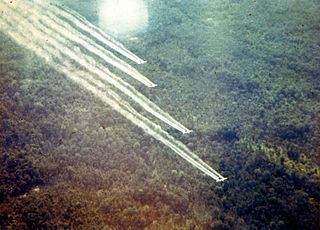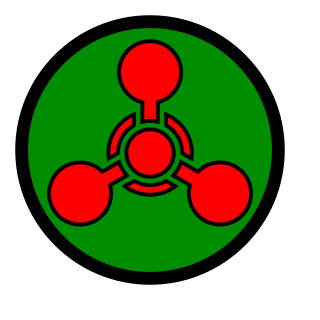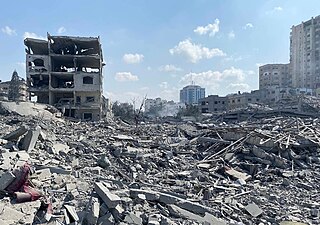
Agent Orange is a chemical herbicide and defoliant, one of the tactical use Rainbow Herbicides. It was used by the U.S. military as part of its herbicidal warfare program, Operation Ranch Hand, during the Vietnam War from 1961 to 1971. The U.S. was strongly influenced by the British who used Agent Orange during the Malayan Emergency. It is a mixture of equal parts of two herbicides, 2,4,5-T and 2,4-D. In addition to its damaging environmental effects, traces of dioxin found in the mixture have caused major health problems and deformities for many individuals who were exposed and for their children.

The Environmental Modification Convention (ENMOD), formally the Convention on the Prohibition of Military or Any Other Hostile Use of Environmental Modification Techniques, is an international treaty prohibiting the military or other hostile use of environmental modification techniques having widespread, long-lasting or severe effects. It opened for signature on 18 May 1977 in Geneva and entered into force on 5 October 1978.

Pesticides are substances that are used to control pests. They include herbicides, insecticides, nematicides, fungicides, and many others. The most common of these are herbicides, which account for approximately 50% of all pesticide use globally. Most pesticides are used as plant protection products, which in general protect plants from weeds, fungi, or insects. In general, a pesticide is a chemical or biological agent that deters, incapacitates, kills, or otherwise discourages pests. Target pests can include insects, plant pathogens, weeds, molluscs, birds, mammals, fish, nematodes (roundworms), and microbes that destroy property, cause nuisance, or spread disease, or are disease vectors. Along with these benefits, pesticides also have drawbacks, such as potential toxicity to humans and other species.

Herbicides, also commonly known as weed killers, are substances used to control undesired plants, also known as weeds. Selective herbicides control specific weed species while leaving the desired crop relatively unharmed, while non-selective herbicides kill plants indiscriminately. The combined effects of herbicides, nitrogen fertilizer, and improved cultivars has increased yields of major crops by three to six times from 1900 to 2000.

A scorched-earth policy is a military strategy of destroying everything that allows an enemy military force to be able to fight a war, including the deprivation and destruction of water, food, humans, animals, plants and any kind of tools and infrastructure. Its use is possible by a retreating army to leave nothing of value worth taking, to weaken the attacking force or by an advancing army to fight against unconventional warfare.

Lewisite (L) (A-243) is an organoarsenic compound. It was once manufactured in the U.S., Japan, Germany and the Soviet Union for use as a chemical weapon, acting as a vesicant and lung irritant. Although the substance is colorless and odorless in its pure form, impure samples of lewisite are a yellow, brown, violet-black, green, or amber oily liquid with a distinctive odor that has been described as similar to geraniums.

Operation Ranch Hand was a U.S. military operation during the Vietnam War, lasting from 1962 until 1971. Largely inspired by the British use of chemicals 2,4,5-T and 2,4-D during the Malayan Emergency in the 1950s, it was part of the overall herbicidal warfare program during the war called "Operation Trail Dust". Ranch Hand involved spraying an estimated 19 million U.S. gallons (72,000 m3) of defoliants and herbicides over rural areas of South Vietnam in an attempt to deprive the Viet Cong of food and vegetation cover. Areas of Laos and Cambodia were also sprayed to a lesser extent. According to the Vietnamese government, the chemicals caused 400,000 deaths. The United States government has described these figures as "unreliable".

A defoliant is any herbicidal chemical sprayed or dusted on plants to cause their leaves to fall off. Defoliants are widely used for the selective removal of weeds in managing croplands and lawns. Worldwide use of defoliants, along with the development of other herbicides and pesticides, allowed for the Green Revolution, an increase in agricultural production in mid-20th century. Defoliants have also been used in warfare as a means to deprive an enemy of food crops and/or hiding cover, most notably by the United Kingdom during the Malayan Emergency and the United States in the Vietnam War. Defoliants were also used by Indonesian forces in various internal security operations.

Agent Blue is one of the "rainbow herbicides" that is known for use by the United States during the Vietnam War. It contained a mixture of dimethylarsinic acid and its related salt, sodium cacodylate, and water.

Herbicidal warfare is the use of substances primarily designed to destroy the plant-based ecosystem of an area. Although herbicidal warfare use chemical substances, its main purpose is to disrupt agricultural food production and/or to destroy plants which provide cover or concealment to the enemy, not to asphyxiate or poison humans and/or destroy human-made structures. Herbicidal warfare has been forbidden by the Environmental Modification Convention since 1978, which bans "any technique for changing the composition or structure of the Earth's biota".

Diquat is the ISO common name for an organic dication that, as a salt with counterions such as bromide or chloride is used as a contact herbicide that produces desiccation and defoliation. Diquat is no longer approved for use in the European Union, although its registration in many other countries including the USA is still valid.

Glufosinate is a naturally occurring broad-spectrum herbicide produced by several species of Streptomyces soil bacteria. Glufosinate is a non-selective, contact herbicide, with some systemic action. Plants may also metabolize bialaphos and phosalacine, other naturally occurring herbicides, directly into glufosinate. The compound irreversibly inhibits glutamine synthetase, an enzyme necessary for the production of glutamine and for ammonia detoxification, giving it antibacterial, antifungal and herbicidal properties. Application of glufosinate to plants leads to reduced glutamine and elevated ammonia levels in tissues, halting photosynthesis and resulting in plant death.

War can heavily damage the environment, and warring countries often place operational requirements ahead of environmental concerns for the duration of the war. Some international law is designed to limit this environmental harm.

Urbicide is a term which describes the deliberate wrecking or "killing" of a city, by direct or indirect means. It literally translates as "city-killing". The term was first coined by the science fiction author Michael Moorcock in 1963 and later used by urban planners and architects to describe 20th century practices of urban restructuring in the United States. Ada Louise Huxtable in 1968 and Marshall Berman in 1996 have written about urban restructuring in areas like the Bronx, and highlight the impacts of aggressive redevelopment on the urban social experience. The term has come into being in an age of rapid globalization and urbanization. Though urbanization trends in the last century have led to a focus on violence and destruction in the context of the city, the practice of urbicide is thousands of years old.

Ecocide is the destruction of the environment by humans. Ecocide threatens all human populations who are dependent on natural resources for maintaining ecosystems and ensuring their ability to support future generations. The Independent Expert Panel for the Legal Definition of Ecocide describes it as "unlawful or wanton acts committed with knowledge that there is a substantial likelihood of severe and either widespread or long-term damage to the environment being caused by those acts".

Study of the environmental impact of war focuses on the modernization of warfare and its increasing effects on the environment. Scorched earth methods have been used for much of recorded history. However, the methods of modern warfare cause far greater devastation on the environment. The progression of warfare from chemical weapons to nuclear weapons has increasingly created stress on ecosystems and the environment. Specific examples of the environmental impact of war include World War I, World War II, the Vietnam War, the Rwandan Civil War, the Kosovo War, the Gulf War, and the 2022 Russian invasion of Ukraine.

A chemical weapon (CW) is a specialized munition that uses chemicals formulated to inflict death or harm on humans. According to the Organisation for the Prohibition of Chemical Weapons (OPCW), this can be any chemical compound intended as a weapon "or its precursor that can cause death, injury, temporary incapacitation or sensory irritation through its chemical action. Munitions or other delivery devices designed to deliver chemical weapons, whether filled or unfilled, are also considered weapons themselves."

Agent Orange is a herbicide, classified as a defoliant, that was used most notably by the U.S. military during the Vietnam War. Its primary purpose was strategic deforestation, destroying the forest cover and food resources necessary for the implementation and sustainability of the North Vietnamese style of guerilla warfare. The U.S. Agent Orange usage reached an apex during Operation Ranch Hand, in which the material was sprayed over 4.5 million acres of land in Vietnam from 1961 to 1971.

Domicide, is the destruction of housing for corporate, political, strategic or bureaucratic reasoning. It can also encompass the widespread destruction of a living environment, forcing the incumbent humans to move elsewhere. In a human rights context, domicide is the deliberate and systematic destruction of housing and basic infrastructure, making an area uninhabitable. The concept of domicide originated in the 1970s, but only assumed its present meaning in 2022, after a report by the UN Special Rapporteur on the Right to Adequate Housing, Balakrishnan Rajagopal

There has been extensive environmental damage caused by the ongoing Israeli invasion of the Gaza Strip, including the destruction of agricultural land, displacement of people, bombing of Gaza, the Israeli blockade, and famine in the Gaza Strip. By March 2024, nearly half of tree cover and farmland in Gaza had been destroyed.


















